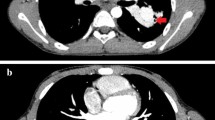Abstract
Background
Pulmonary arteriovenous malformations are abnormal communications between the pulmonary arterial and venous vasculature leading to a right-to-left blood shunt. Based on possible complications, including hypoxemia, hemorrhage, infection and paradoxical embolism, deactivation of the malformation from the circulation is the treatment option of choice, either by interventional embolization or by surgery. Embolization is less invasive and has widely replaced surgery, but bears the risk of revascularization, recanalization and downstream migration of the device with paradoxical embolism.
Methods
We report on the case of a 76-year-old male patient suffering from a complex, plexiform pulmonary arteriovenous malformation in the lingula, which was treated by video-assisted thoracoscopic surgery and anatomic lingula resection. Patient’s medical history, clinical examination and imaging studies did not reveal any evidence of hereditary hemorrhagic telangiectasia.
Results
Left-sided anterior three-port video-assisted thoracoscopic surgery (VATS) approach was used. Instead of only wedge resecting the very peripherally located pulmonary arteriovenous malformation, the lingular vessels were controlled centrally and an anatomic lingula resection was performed in order to prevent a more central re-malformation. To prevent rupture of the aneurysm sac through pressure overload, the feeding arteries were controlled before the draining vein. Duration of the total procedure was 151 min, the single chest tube was removed on the postoperative day 3, and the patient was discharged on the postoperative day 6.
Conclusion
Although interventional embolism of the feeding artery of a pulmonary arteriovenous malformation is the current therapeutic gold standard, minimally invasive anatomic lung resection by video-assisted thoracoscopic surgery can be considered, especially for the treatment of solitary large arteriovenous malformations. By anatomic lung resection, the risk of recanalization, collateralization and peri-interventional paradoxical embolism may be reduced.
Similar content being viewed by others
References
Cartin-Ceba R, Swanson KL, Krowka MJ (2013) Pulmonary arteriovenous malformations. Chest 144:1033–1044
Wong HH, Chan RP, Klatt R, Faughnan ME (2011) Idiopathic pulmonary arteriovenous malformations: clinical and imaging characteristics. Eur Respir J 38:368–375
Hsu CC, Kwan GN, Thompson SA, Evans-Barns H, van Driel ML (2012) Embolisation for pulmonary arteriovenous malformation. Cochrane Database Syst Rev 8:CD008017. doi:10.1002/14651858.CD008017.pub3
Khurshid I, Downie GH (2002) Pulmonary arteriovenous malformation. Postgrad Med J 78:191–197
Shovlin CL, Guttmacher AE, Buscarini E, Faughnan ME, Hyland RH, Westermann CJ, Kjeldsen AD, Plauchu H (2000) Diagnostic criteria for hereditary hemorrhagic telangiectasia (Rendu-Osler-Weber syndrome). Am J Med Genet 91:66–67
Hart JL, Aldin Z, Braude P, Shovlin CL, Jackson J (2010) Embolization of pulmonary arteriovenous malformations using the Amplatzer vascular plug: successful treatment of 69 consecutive patients. Eur Radiol 20:2663–2670
Cottin V, Dupuis-Girod S, Lesca G, Cordier JF (2007) Pulmonary vascular manifestations of hereditary hemorrhagic telangiectasia (Rendu-Osler disease). Respiration 74:361–378
Shovlin CL, Jackson JE, Bamford KB, Jenkins IH, Benjamin AR, Ramadan H, Kulinskaya E (2008) Primary determinants of ischaemic stroke/brain abscess risks are independent of severity of pulmonary arteriovenous malformations in hereditary haemorrhagic telangiectasia. Thorax 63:259–266
Ference BA, Shannon TM, White RI Jr, Zawin M, Burdge CM (1994) Life-threatening pulmonary hemorrhage with pulmonary arteriovenous malformations and hereditary hemorrhagic telangiectasia. Chest 106:1387–1390
Woodward CS, Pyeritz RE, Chittams JL, Trerotola SO (2013) Treated pulmonary arteriovenous malformations: patterns of persistence and associated retreatment success. Radiology 269:919–926
Watanabe N, Munakata Y, Ogiwara M, Miyatake M, Nakagawa F, Hirayama J (1995) A case of pulmonary arteriovenous malformation in a patient with brain abscess successfully treated with video-assisted thoracoscopic resection. Chest 108:1724–1727
Reichert M, Kerber S, Amati AL, Bodner J (2014) Total video-assisted thoracoscopic (VATS) resection of a left-sided sulcus superior tumor after induction radiochemotherapy: video and review. Surg Endosc. doi:10.1007/s00464-014-3952-5
Handy JR Jr, Asaph JW, Douville EC, Ott GY, Grunkemeier GL, Wu Y (2010) Does video-assisted thoracoscopic lobectomy for lung cancer provide improved functional outcomes compared with open lobectomy? Eur J Cardiothorac Surg 37:451–455
Whitson BA, Groth SS, Duval SJ, Swanson SJ, Maddaus MA (2008) Surgery for early-stage non-small cell lung cancer: a systematic review of the video-assisted thoracoscopic surgery versus thoracotomy approaches to lobectomy. Ann Thorac Surg 86:2008–2018
Demmy TL, Nwogu C (2008) Is video-assisted thoracic surgery lobectomy better? Quality of life considerations. Ann Thorac Surg 85:S719–S728
Huang J, Xu X, Chen H, Yin W, Shao W, Xiong X, He J (2013) Feasibility of complete video-assisted thoracoscopic surgery following neoadjuvant therapy for locally advanced non-small cell lung cancer. J Thorac Dis 5:S267–S273
Acknowledgments
We thank Christoph Winter and colleagues from the “Diagnostikzentrum Radiologie + Neurologie,” Paul Zipp Street 171-173, 35398 Giessen, Germany, for the permission to demonstrate chest computed tomography images of the PAVM.
Author information
Authors and Affiliations
Corresponding author
Ethics declarations
Disclosures
Martin Reichert, Stefanie Kerber, Ibrahim Alkoudmani and Johannes Bodner have no conflicts of interest or financial ties to disclose.
Informed consent
Informed consent was obtained from the patient for publication of the clinical course and operation video.
Electronic supplementary material
Below is the link to the electronic supplementary material.
Supplementary material 1 (WMV 292304 kb)
Rights and permissions
About this article
Cite this article
Reichert, M., Kerber, S., Alkoudmani, I. et al. Management of a solitary pulmonary arteriovenous malformation by video-assisted thoracoscopic surgery and anatomic lingula resection: video and review. Surg Endosc 30, 1667–1669 (2016). https://doi.org/10.1007/s00464-015-4337-0
Received:
Accepted:
Published:
Issue Date:
DOI: https://doi.org/10.1007/s00464-015-4337-0




